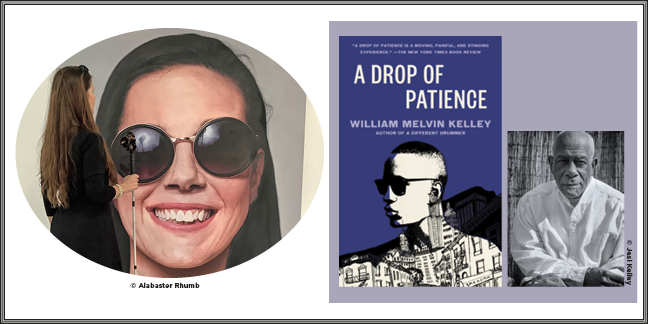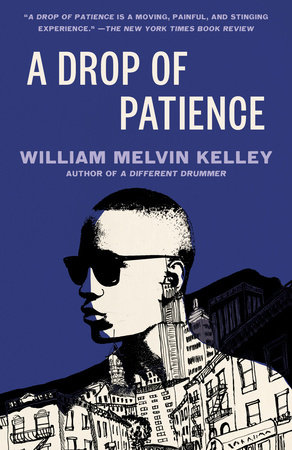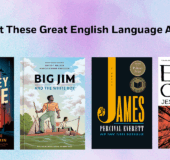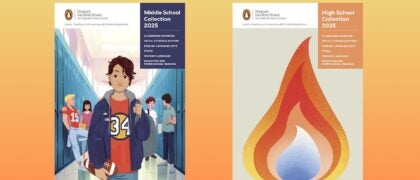Written by By M. Leona Godin, author of There Plant Eyes: A Personal and Cultural History of Blindness
In William Melvin Kelley’s A Drop of Patience, we follow the life of a young Black musician named Ludlow Washington, who is placed in a school for the blind when he is five and remains there until he is sixteen. Thanks to his musical talent, he was then sold into the “custody of a Mister Bud Rodney, a Negro bandleader” by the warden of the school to play in a nightclub until released at age eighteen. Blindness is often associated with innocence, especially in a Christian context: if you can’t see, you can’t sin, right? Perhaps it is this line of thought that provoked Kelley to paint the young Ludlow as extremely naive when he enters this smoky world of jazz, booze, and prostitutes.
Blindness is often associated with innocence, especially in a Christian context: if you can’t see, you can’t sin, right? Perhaps it is this line of thought that provoked Kelley to paint the young Ludlow as extremely naive when he enters this smoky world of jazz, booze, and prostitutes.
Nonetheless, teenagers—with and without sight—are a maelstrom of hormones. Ray Charles, who attended a school for the blind in the 1930s and ’40s, explains in Brother Ray how one girl helped her boyfriend find his way to her room by constructing an elaborate braille map: “This diagram was really somethin’ else—all detailed and precise and even included a contingency option for dealing with the night watchman if he happened to show up.”
Not surprisingly, things don’t go especially well with Ludlow’s first sexual experience, but by the time this chapter of his life ends, he is married with a child, whom he leaves behind to join a band in New York City. There he hooks up with a white woman, which ends painfully, and precipitates a “crack up.” When he recovers he tries to make sense of the episode and tells his friend: “‘I don’t know what it was—not having no family, or not having no eyes, or something else—but I didn’t grow up learning all the things I should. I mean, the blind home taught me how to eat my food and cross the street, but they left out some things.’”
As a blind person, I appreciate this moment because it suggests that it wasn’t Ludlow’s blindness that was the problem, it was a system that plucked a poor Black boy from his family and kept him institutionalized that was to blame for his difficulties in the world of relationships. On the other hand, a blind reader may find some things don’t ring true in Kelley’s novel. For example, Ludlow’s face touching. Most of us only touch faces in the same contexts that sighted people touch faces—intimate moments with loved ones and children, not to gain information about beauty or ugliness.
In 1965, when A Drop of Patience was published, the civil rights movement was in full swing, but the disability rights movement was just getting started. It’s useful to put Kelley’s novel into a context of human rights and consider how that shifting landscape can inform our reading of a book about Blackness and blindness.
In 1965, when A Drop of Patience was published, the civil rights movement was in full swing, but the disability rights movement was just getting started. It’s useful to put Kelley’s novel into a context of human rights and consider how that shifting landscape can inform our reading of a book about Blackness and blindness.
Sixty years ago, blindness was understood only as an affliction to be overcome. (Many still think of it as such.) Although extraordinary talents can rise above low expectations, the stellar rise of some “inspirational” individuals can only do so much good, especially if they nurture some internalized ableism of their own.
In Brother Ray, Charles declares that “there were three things I never wanted to own when I was a kid: a dog, a cane, and a guitar. In my brain, they each meant blindness and helplessness. (Seems like every blind blues singer I’d heard about was playing the guitar.)” For Charles, not wanting to “look blind” was an animating force. In my book, There Plant Eyes: A Personal and Cultural History of Blindness, I argue that this fear of the stigma of blindness can often be as debilitating as the blindness itself.
The central conceit in A Drop of Patience revolves around the question: what might being Black mean to a blind person? The climactic moment of Ludlow’s “crack up” is a cringy scene where he puts on “blackface” and tells a terrible racist joke. It reveals how mystifying the whole race question was for Ludlow. Why should something as superficial as skin color make such a difference? Why should it have caused his white girlfriend to be so skittish and eventually leave him?
Ludlow’s blindness reads as a metaphor for the incomprehensibility of racism. But it’s important to remember that blind and disabled people have been oppressed by the nondisabled culture in ways that are analogous to other forms of discrimination. To consider blindness only as a metaphor does us a disservice. There Plant Eyes can help students contextualize blind characters like Ludlow within blind culture and history. Reading novels that feature blind characters written by sighted authors, such as A Drop of Patience (or more recently, All the Light We Cannot See), should urge us to investigate the relationship between the metaphors of blindness and the lived blind experience.






